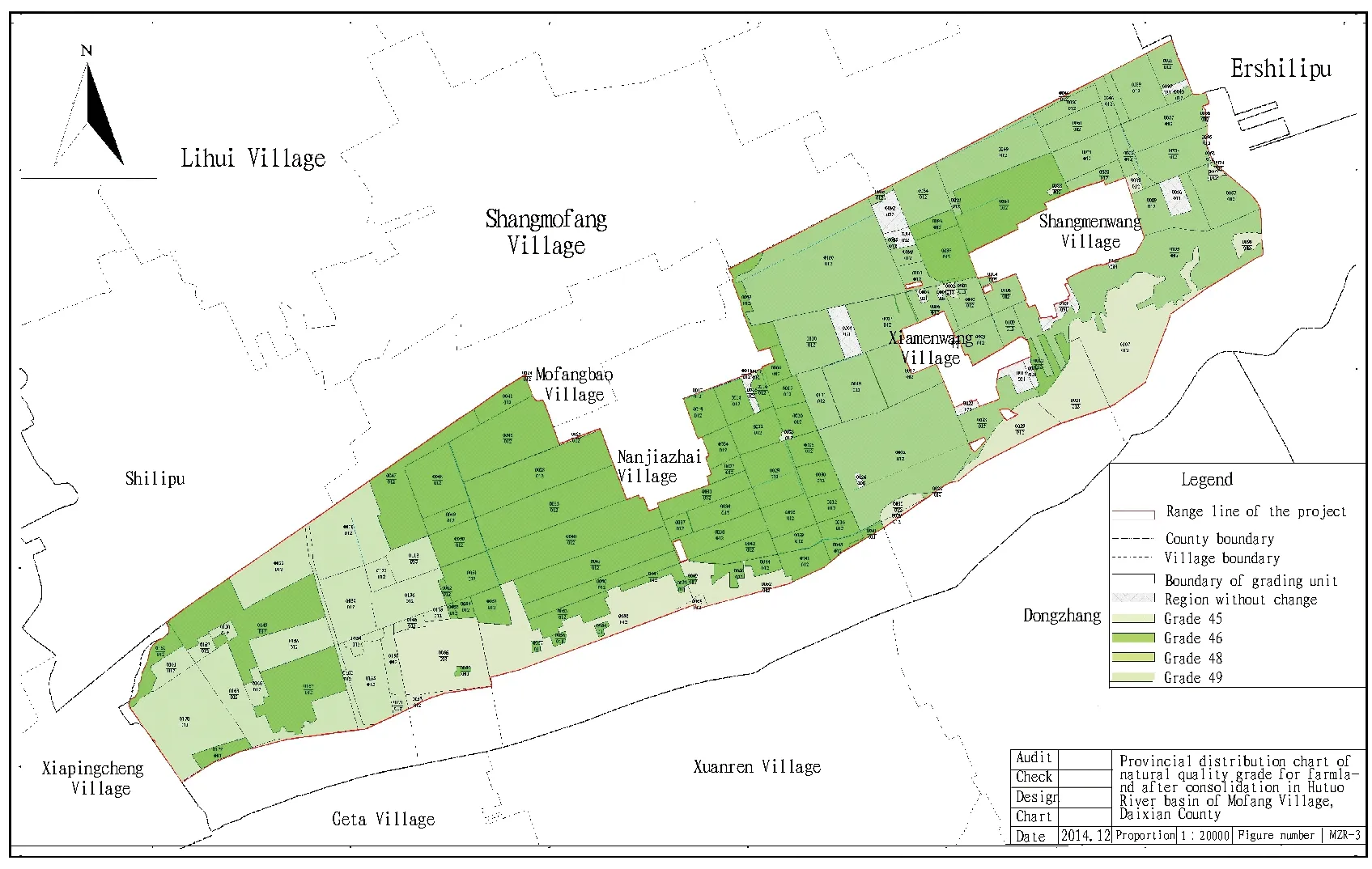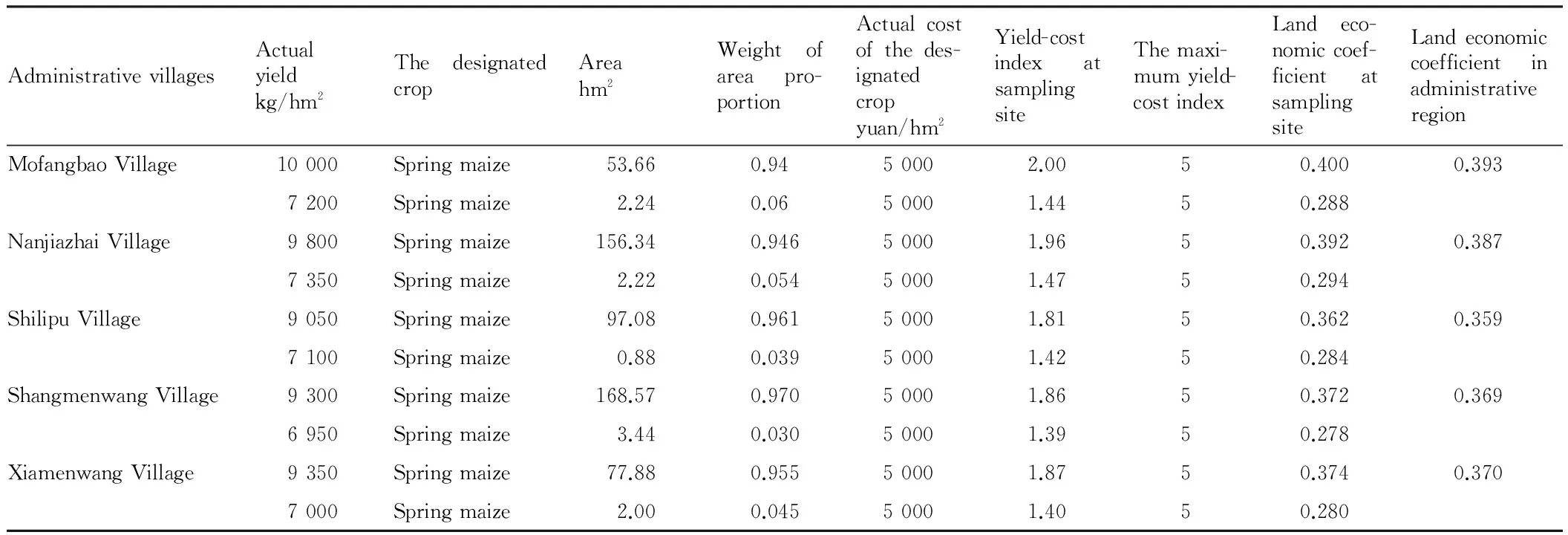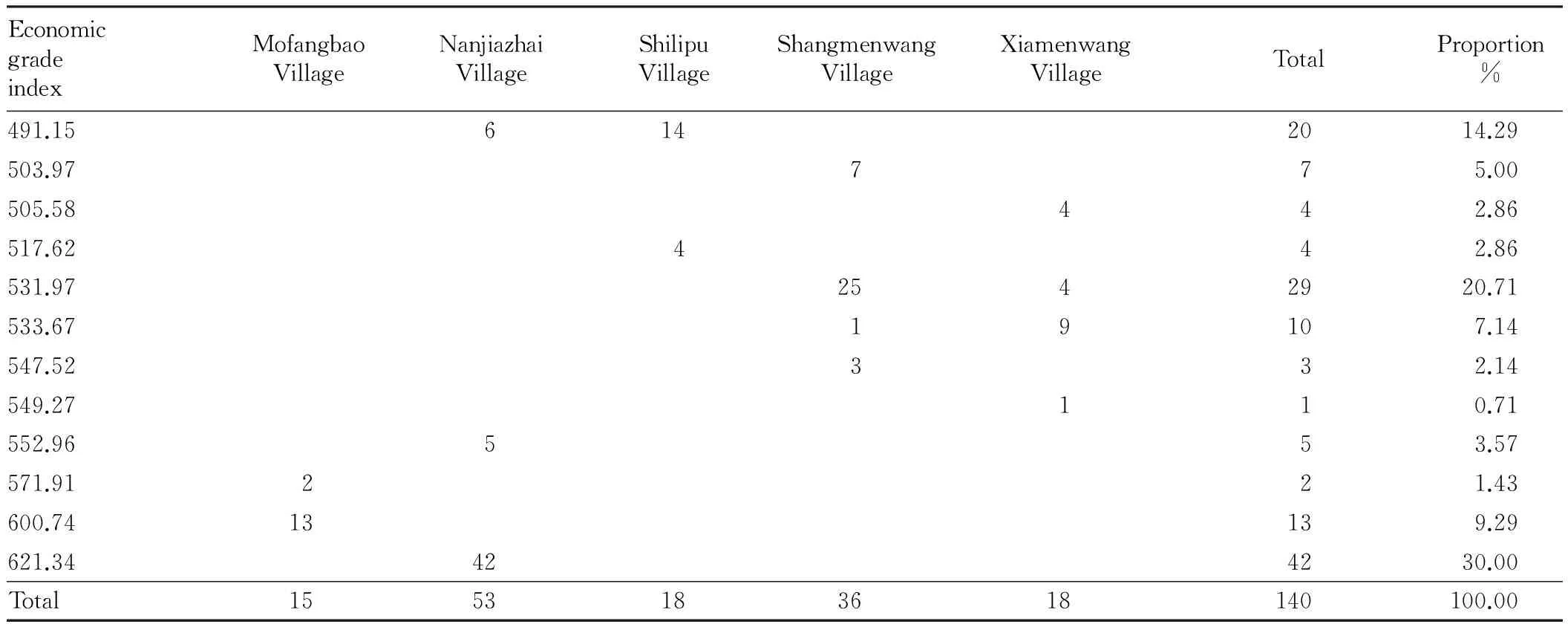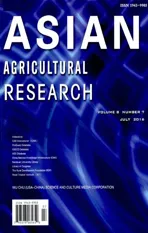Research of Farmland Quality Evaluation Based on Land Consolidation
——A Case Study of Land Consolidation Project in Mofang Village, Daixian County, Shanxi Province
2016-01-12,
,
1. College of Information, Shanxi Agricultural University, Taigu 030800, China; 2. College of Economics & Management, Anhui Agricultural University, Hefei 230036, China
1 Introduction
In 2010, the State Council issued theNoticeonStrictlyStandardizingthePilotfortheBalancebetweenIncreaseandDecreaseofUrbanandRuralConstructionLandandConscientiouslyDoingaGoodJobinRuralLandConsolidationWork(Guofa[2010]47), which further clearly put forward that "quality assessment and acceptance of the newly increased farmland by land consolidation should be conducted by technical specifications and standards of farmland grading". The requirement clearly points out that farmland quality grade evaluation must be conducted after land development and consolidation project finish, and technical method of quality assessment of the newly added farmland is unified, making that quality acceptance of the newly added farmland by land development and consolidation has quantization standard, and conversion work of the supplemented farmland quantity and quality by the grade obtains substantive promotion. The evaluation of farmland quality grade is conducted after land development and consolidation project finish, and quality of agricultural land in the project region is identified again. By contrasting and analyzing changes of agricultural land in quantity and quality before and after the project implementation, the contribution of land development and consolidation project to improving grain production capacity of agricultural land is quantized. The target is to analyze grain production capacity by evaluating the grade of agricultural land in the project region after land development and consolidation project finish, which could provide technical support for conversion of farmland requisition-compensation balance according to the grade and quality report of the developed farmland.
2 General introduction of the project region
The project region involves Shangmenwang Village, Xiamenwang Village, Nanjiazhai Village, Mofangbao Village and Shilipu Village of Mofang Township, Daixian County, and its geographical position is at 112°59′33″-113°03′30″ E, 39°04′50″-39°06′53″ N. The east of project region is to Ershilipu Village; south extends to the boundary of township; north near National Highway 108; south borders coastal area of the Hutuo River. Total scale of the developed and arranged land is 651.91 hm2.
3 Grade evaluation of farmland quality after land consolidation
3.1WorkingbasemapThe current arable land of theConsolidationProjectofBasicFarmlandintheHutuoRiverBasinofMofangVillageofDaixianCountytakes status quo map of land use as base map, and the newly added farmland takes completion map as base map. They are overlapped with grading result map of agricultural land (natural quality grade map, use grade map and economic grade map) in the project region, which is taken as working base map of farmland quality grade evaluation.
3.2Therelatedparametersoffarmlandqualitygradeevaluation
3.2.1Standard cropping system, reference crop and the designated crop. Standard cropping system:standard cropping system of the farmland quality evaluation mainly indicates plantation system, and it is single cropping system in Daixian County.
Reference crop: spring maize is determined as reference crop of agricultural land grading in Shanxi Province.
The designated crop:according to the designated crop for the last round of agricultural land grading, the designated crops for agricultural land grading in Daixian County are spring maize, millet, potato and soybean. The project region all belongs to central plain zone of District 3, including Mofangbao Village, Nanjiazhai Village, Shilipu Village, Shangmenwang Village and Xiamenwang Village, and the designated crop is spring maize.
3.2.2DivisionofgradingfactorindexzoneGrading factor index zone is the zone of grading factor evaluation index system calculating natural quality score of agricultural land. According to terrain characteristics, combining soil and its environmental factors, and taking the principle of dominant factor, the principle of regional differentiation, the principle of boundary integrity and the principle of coordination with surrounding county (city and district) as the guidance, Daixian County is divided into three grading factor index zones: Wutaishan district of Hengshan(District 1), basin district of Xinding(District 2)and basin district of Xinding(District 3). The project belongs to Grade-one index district (loess plateau district), and Grade-two index district is basin district of Xinding (District 3), and the five villages all belong to the central plain zone.
3.3Calculationofnaturalqualityscoreanddivisionofnaturalqualitygrade
3.3.1Classification of each grading factor and scoring rule table.According to factor index zone, corresponding index grade of grading factor, quality score and the designated crop are used to make relationship table of "designated crop-grading factor-natural quality score". According to the planting situation of the project, the designated crop in District 3 of Xinding basin is "spring maize", and scoring rule is shown as Table 1.
Table1Scoringruleof"designatedcrop-gradingfactor-naturalqualityscore"intheprojectregion

Grade-twoindexdistrictFactorindexdistrictScoreofthedesignatedcrop(springmaize)GradingfactorsOrganicmatterSurfacetextureGuaranteedprobabilityofirrigationXindingbasinDistrict3100LoamSufficientlymeetingdistrict(District3)90ClayBasicallymeeting80Grade370Grade4SandysoilGenerallymeeting50WithoutirrigationconditionWeight0.450.250.3
3.3.2Calculation of natural quality score. According to the weight of "designated crop-grading factor-natural quality score" and scoring rule in Daixian County, natural quality score of each grading factor for the designated crop is calculated by factor method. Via weighted mean, natural quality score of agricultural land in each evaluated unit of farmland quality grade in the project region is calculated according to the designated crop. Calculation formula for natural quality score of agricultural land is as below[1]:

whereWkis the weight of thekthgrading factor;CLijis natural quality score of agricultural land for the designated crop in the grading unit;iis the serial number of grading unit;jis the serial number of designated crop;kis the serial number of grading factor;mis the number of grading factor;fijkis index score of thekth grading factor for thejthkind of designated crop in theith grading unit, and its value is (0-100].
Via the calculation, scoring situation of grading factor for each designated crop in the evaluated unit of farmland quality grade after project implementation and calculation result of natural quality score are shown as Fig.1.
3.4CalculationoflandutilizationcoefficientanddivisionofutilizationgradeTo sufficiently reflect management status of agricultural land,it needs land economic coefficient modifying utilization grade index of agricultural land, thereby obtaing agricultural land grade index. Land economic coefficient embodies relative difference for ratio of yield and cost, and reflects spatial difference distribution rule of land input-output in different regions and different profits generated by different land inputs from the farmers.
3.4.1"Yield-cost" index[2]of the designated crop at the sampling site. Calculation formula for "yield-cost" index of the designated crop is as below:

whereajis "yield-cost" index of the sampling site;Yjis actual per unit area yield of thejthkind of designated crop;Cjis actual cost of thejthkind of designated crop at the sampling site.
According to the obtained per unit area input and output data of the designated crop by investigation at the sampling site of the project region, using the above formula, "yield-cost" index of the designated crop at each sampling site of the project region is calculated, and results are shown as Table 2.
3.4.2The maximum "yield-cost" index of the designated crop. The designated crop in the project region is spring maize, and its "yield-cost" index is 5.0 kg/yuan.
3.4.3Land economic coefficient[3]of the designated crop at sampling site. Land economic coefficient of the designated crop at sampling site is calculated according to below formula:

whereKcijis land economic coefficient of thejthkind of designated crop at the ith sampling site;aijis "yield-cost" index of thejthkind of designated crop at the ith sampling site;Ajis the maximum of "yield-cost" index for thejth kind of designated crop in Daixian County. According to the formula, land utilization coefficient of the designated crop at each sampling site is calculated, and results are shown as Table 2.

Fig.1 The distribution of natural quality grade in the project region after land consolidation
Table2Calculationresultoflandeconomiccoefficientineachadministrativevillage

AdministrativevillagesActualyieldkg/hm2ThedesignatedcropAreahm2Weightofareapro-portionActualcostofthedes-ignatedcropyuan/hm2Yield-costindexatsamplingsiteThemaxi-mumyield-costindexLandeco-nomiccoef-ficientatsamplingsiteLandeconomiccoefficientinadministrativeregionMofangbaoVillage10000Springmaize53.660.9450002.0050.4000.3937200Springmaize2.240.0650001.4450.288NanjiazhaiVillage9800Springmaize156.340.94650001.9650.3920.3877350Springmaize2.220.05450001.4750.294ShilipuVillage9050Springmaize97.080.96150001.8150.3620.3597100Springmaize0.880.03950001.4250.284ShangmenwangVillage9300Springmaize168.570.97050001.8650.3720.3696950Springmaize3.440.03050001.3950.278XiamenwangVillage9350Springmaize77.880.95550001.8750.3740.3707000Springmaize2.000.04550001.4050.280
3.4.4Economic grade index of agricultural land. Via utilization grade index of agricultural land and land economic coefficient, agricultural land grade index of the designated crop could be calculated, thereby obtaining economic grade index of agricultural land in each evaluated unit of farmland quality grade.
Calculation formula for economic grade index of agricultural land for the designated crop is as below[4-5]:
Gij=Yij·Kcj
Gi=∑Gij
whereGijis land economic grade index of thejthkind of designated crop in the ith grading unit;Yijis land utilization grade index of thejth kind of designated crop in the ith grading unit;Kcjis land economic coefficient of thejthkind of designated crop in isochore of the grading unit;Giis agricultural land grade index of theith grading unit.
Via calculation, calculation results for economic grade index of agricultural land in the project region are shown as Table 3 and Fig.2. Seen from Table 3, land economic grade index of the project is between 494.15 and 621.34, in which 621.34 has the most extensive distribution frequency, and it has 42 distribution units, which accounts for 30% of total unit number. Seen from analysis on each administrative village, due to social economy, location and natural factors in Nanjiazhai Village, farmland in the region has higher economic grade (621.34);natural quality and land utilization degree in Mofangbao Village are higher, and its land economic grade index is also higher, which ranges between 571.91 and 600.74;economic grade is moderate in Shangmenwang Village and Xiamenwang Village, which ranges between 503.97 and 549.27;natural quality condition in Shilipu Village is lower, and land utilization degree is worse, which causes its economic index is the lowest (491.15-517.62).
Table3Frequencydistributionofeconomicgradeindexineachvillageafterlandconsolidation

EconomicgradeindexMofangbaoVillageNanjiazhaiVillageShilipuVillageShangmenwangVillageXiamenwangVillageTotalProportion%491.156142014.29503.97775.00505.58442.86517.62442.86531.972542920.71533.6719107.14547.52332.14549.27110.71552.96553.57571.91221.43600.7413139.29621.34424230.00Total1553183618140100.00

Fig.2 The distribution of farmland utilization grade after land consolidation in the project region
4 Analysis on evaluation of farmland quality grade
4.1AssessmentofnaturalqualitygradeafterconsolidationAfter land consolidation, natural quality of agricultural land in the project region is improved somewhat by matching irrigation and drainage facilities. Therefore, natural quality grade after consolidation distributes between Grade 45 and Grade 49. By soil covering, land leveling and matching irrigation and drainage facilities, quality on the newly increased farmland could reach farmland standard.
4.2ComparisonofutilizationgradebeforeandafterconsolidationAfter land consolidation, via integrated land arrangement and matching of field, water, road and forest, land yield in the project region is improved greatly, and land utilization grade is improved to Grades 28-32. By soil covering, land leveling and matching irrigation and drainage facilities on the newly increased farmland, land utilization index reaches over Grade 28. That is to say, the area of agricultural land whose utilization grade after consolidation could be improved to Grade 28 is 122.82 hm2, which accounts for 20.23% of total agricultural land area after consolidation;the area of agricultural land which is promoted to Grade 29 is 265.52 hm2, which accounts for 43.73% of total agricultural area
after consolidation;the area of agricultural land which is promoted to Grade 30 is 37.25 hm2, which accounts for 6.14% of total agricultural land after consolidation;the area of agricultural land which is promoted to Grade 32 is 181.61 hm2,which accounts for 29.91% of total agricultural land after consolidation.
In summary, via land consolidation project, a piece of swamp and messy ridge are remedied into farmland, which increases effective farmland area. By implementing land leveling project, farmland water conservancy project, field road project and farmland protection project, and reasonly deploying distribution structure of field, water, road and forest in the project region, infrastructure supporting construction is realized, and basic condition of agricultural production in the project region is improved radically, which lays the foundation for electrification, mechanization and large-scale production. It makes that the cultivation conditions of the original cultivated land have been improved, and quality of the newly added farmland reaches the equivalent cultivated land’s level, and farmland quality level is improved by one grade than before. It has an important significance for improving integrated production ability of farmland and laying a solid foundation for stabilizing grain production.
[1] WANG HB, WANG XB, ZHU DJ. Numerical computation of natural quality marks for farmland classification in Wanbo forest district[J]. China Land Science, 2002(2): 32-35.(in Chinese).
[2] YANG XF, ZHANG SL, YAN Y,etal. Analysis on the defects of land appraisal and the mended methods[J].Journal of Anhui Agricultural Sciences, 2009(1): 290-292.(in Chinese).
[3] QI NT, MA P. Evaluation on the status quo and developing characteristics of farmland utilization using land utilization and economic coefficient ——Taking the case of Jiangxi Province[J]. Acta Agriculturae Jiangxi, 2008(11) :124-126. (in Chinese).
[4] AN ZY, DONG K, LI WM,etal. A brief analysis on economic coefficient farmland classification[J]. Co-Operative Economy & Science, 2015(4):43-44. (in Chinese).
[5] ZHOU WP. Comparative study on calculation method of the land economic coefficient in farmland classification of county-level——Taking an example of Shanggao[J]. Journal of Yichun University,2009,31(6):114-117. (in Chinese).
杂志排行
Asian Agricultural Research的其它文章
- Economic Analysis on the Rational Allocation of Agricultural Production Factors in Henan Province
- Special Space and Plant Landscape Design of Urban Ecological Buildings
- Main Methods Applied in Fertigation Technology
- A Study on the Ultrasonic Extraction and Antioxidant Activity of Lychee Pericarp Polysaccharides
- The Fishery Industrial Structure in China Based on the Application of Shift-Share Analysis
- Spatial Structure of Tourism Resources in Liaoning Province
